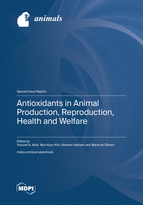Antioxidants in Animal Production, Reproduction, Health and Welfare
A special issue of Animals (ISSN 2076-2615).
Deadline for manuscript submissions: closed (24 August 2022) | Viewed by 76100
Special Issue Editors
Interests: poultry sciences; rabbits sciences; Nutrition; husbandry; Production; physiology
Interests: feed additives on performance and nutrient utilization in poultry identification of antibiotics alternatives in poultry; mineral nutrition & amp; bone growth in poultry; nutrient absorption and transporters (amino acids & minerals) in intestine
Interests: livestock, reproduction, assisted reproductive techniques; nanotechnology; ultrasound; endocrinology; phytochemicals; antioxidants; growth
Special Issues, Collections and Topics in MDPI journals
Special Issue Information
Dear Colleagues,
Redox homeostasis is a pivotal biological process that guarantees the balance between two molecules—antioxidants and reactive oxygen species (ROS). Normally, a moderate production of ROS is required for the maintenance of many biological processes in the cell; however, the excessive accumulation of ROS, which results in oxidative stress, may evoke structural and functional impairments by attacking cells’ biomolecules (proteins, lipids, and genetic material) and cell membranes, leading to cell dysfunction or cell death based on the magnitude of these reactions. As a defense mechanism, different cells are provided with many ROS-scavenging enzymatic and non-enzymatic antioxidant molecules to eliminate ROS and maintain adequate redox homeostasis. The exposure of animals to environmental stresses (restraint, bad housing conditions, irradiation, pollution, diseases, and heat stress) and endogenous stresses (metabolic and physiological disorders) can seriously disrupt the redox homeostasis, leading to impairments in animals’ health and overall performance. Under these circumstances, the self-antioxidant defense system maybe not enough to neutralize ROS effects. In this context, the utilization of an exogenous source of antioxidants, mainly dietary sources, may present an effective and cost-effective solution. There are a plethora of substances, either naturally occurring or synthesized (organic acids, minerals, vitamins, hormones, and specific feed additives originating from plants such as essential oils and polyphenols), known for their antioxidant activity, that can be used to maintain adequate redox status in animals in order to preserve their well-being and/or productivity. This area of research still needs more investigations in order to clearly elucidate the effective antioxidant substances that could be used in practical applications, with an emphasis on their biological mechanisms during different physiological conditions and health statuses. We intend to bring together current research concerning the role of antioxidant substances either from natural sources or those synthesized for improving animal production, reproduction, health, and welfare.
Prof. Dr. Youssef A. Attia
Dr. Woo Kyun Kim
Prof. Dr. Nesrein Hashem
Prof. Dr. Maria de Olivera
Guest Editors
Manuscript Submission Information
Manuscripts should be submitted online at www.mdpi.com by registering and logging in to this website. Once you are registered, click here to go to the submission form. Manuscripts can be submitted until the deadline. All submissions that pass pre-check are peer-reviewed. Accepted papers will be published continuously in the journal (as soon as accepted) and will be listed together on the special issue website. Research articles, review articles as well as short communications are invited. For planned papers, a title and short abstract (about 100 words) can be sent to the Editorial Office for announcement on this website.
Submitted manuscripts should not have been published previously, nor be under consideration for publication elsewhere (except conference proceedings papers). All manuscripts are thoroughly refereed through a single-blind peer-review process. A guide for authors and other relevant information for submission of manuscripts is available on the Instructions for Authors page. Animals is an international peer-reviewed open access semimonthly journal published by MDPI.
Please visit the Instructions for Authors page before submitting a manuscript. The Article Processing Charge (APC) for publication in this open access journal is 2400 CHF (Swiss Francs). Submitted papers should be well formatted and use good English. Authors may use MDPI's English editing service prior to publication or during author revisions.
Keywords
- antioxidants
- animal nutrition
- production
- reproduction
- health
- welfare








